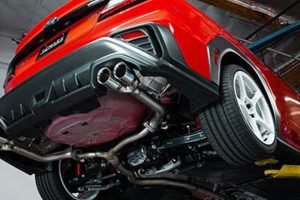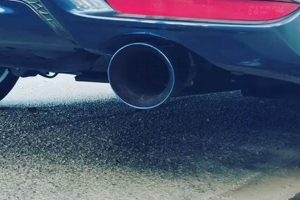An exhaust modification involves the removal of a specific component from a vehicle’s exhaust system. This component, traditionally designed to reduce noise levels, is omitted. The purpose of this alteration is typically to alter the sound characteristics of the vehicle. For example, on a sports car, this may result in a louder, more aggressive engine note.
The practice offers potential benefits such as weight reduction and increased exhaust flow, theoretically leading to enhanced engine performance. Historically, modifications of this type were common in racing applications where sound regulations were less stringent and performance gains were prioritized. Their use in street vehicles has grown alongside an increased consumer desire for personalized vehicle aesthetics and auditory experiences.
The following sections will delve into the practical considerations, potential impacts on vehicle performance, legal implications, and alternative approaches related to this modification, providing a balanced overview for informed decision-making.
Important Considerations Regarding Exhaust System Modifications
Before undertaking alterations to a vehicle’s exhaust, several factors warrant careful consideration. These tips aim to provide essential information for responsible and informed decision-making.
Tip 1: Legal Compliance: Prior to any modification, thoroughly research local and regional regulations concerning exhaust noise levels. Many jurisdictions have specific decibel limits that must be adhered to. Failure to comply can result in fines or required remediation.
Tip 2: Potential Performance Impact: While some anticipate horsepower gains from enhanced exhaust flow, this is not guaranteed. In some cases, alterations can negatively impact engine performance, particularly if the engine management system is not properly recalibrated to compensate.
Tip 3: Sound Quality and Drone: Evaluate the expected sound profile carefully. Modifications often result in increased noise levels. Consider the potential for “drone,” an unpleasant low-frequency resonance, especially at highway speeds. Listen to examples or simulations whenever possible.
Tip 4: Resale Value Implications: Recognize that alterations from factory specifications can potentially reduce the resale value of the vehicle. Some buyers may be deterred by modifications, particularly if they are perceived as excessive or non-compliant with regulations.
Tip 5: Professional Installation: If unfamiliar with automotive mechanics, seek professional installation. Incorrect installation can lead to exhaust leaks, damage to other vehicle components, or even safety hazards.
Tip 6: Alternative Options: Explore alternatives such as aftermarket performance mufflers. These components often provide an enhanced sound without the drastic increase in volume or potential legal issues associated with more extreme modifications.
Tip 7: Consider the Vehicle’s Intended Use: Align the modifications with the primary purpose of the vehicle. Modifications that are suitable for a track car may be impractical or undesirable for a daily driver.
Careful consideration of these points is crucial to ensure that any adjustments made to the exhaust system align with legal requirements, personal preferences, and the overall suitability of the vehicle. Evaluating these factors will contribute to a more satisfactory outcome.
The following sections will elaborate on specific performance considerations and provide guidance on selecting appropriate aftermarket components.
1. Sound Amplification
Sound amplification is a primary and readily apparent consequence of deleting a vehicle’s mufflers. The deletion directly impacts the exhaust’s sound dampening capability, substantially increasing the perceived loudness and altering the tonal characteristics of the engine’s exhaust note.
- Removal of Sound Dampening
The muffler’s primary function is to reduce sound pressure waves generated by the engine’s combustion process. Eliminating this component allows these waves to exit the exhaust system with minimal obstruction, resulting in significantly higher decibel levels. This is often perceived as a deeper, more aggressive sound.
- Altered Tonal Characteristics
Besides increasing volume, the elimination often changes the sound’s tonal qualities. Factory mufflers are designed to attenuate certain frequencies, resulting in a specific sound signature. Deletion bypasses this filtering, accentuating higher frequencies and producing a raspier, less refined exhaust note. This change is noticeable during acceleration and deceleration.
- Potential for Drone
Amplification can introduce unwanted low-frequency resonance, known as drone. This drone is particularly noticeable at certain engine speeds and can create an uncomfortable in-cabin experience, especially during long drives. The specific frequency and intensity of the drone vary depending on the vehicle’s exhaust system design and engine characteristics.
- Impact on Environment and Regulations
Substantial sound amplification can lead to noise pollution, negatively impacting surrounding environments. Many jurisdictions have noise level regulations that prohibit excessively loud vehicles. Modifying an exhaust system in a way that violates these regulations can result in fines and legal repercussions.
These distinct sound characteristics fundamentally alter a vehicle’s auditory signature, impacting its appeal and legal compliance. Understanding these trade-offs is vital for those considering such modification.
2. Exhaust Flow
Exhaust flow constitutes a critical aspect of internal combustion engine performance, directly influencing efficiency and power output. The modification involving the removal of mufflers is frequently undertaken with the intention of optimizing this flow.
- Reduced Backpressure
Mufflers introduce a degree of backpressure within the exhaust system. Elimination reduces this resistance, potentially allowing exhaust gases to exit the engine more freely. Real-world implications include a theoretical improvement in engine breathing, particularly at higher RPMs. However, this benefit is contingent upon other factors within the overall exhaust system design.
- Scavenging Effect Alteration
The exhaust system design influences the scavenging effect, the process by which exhaust pulses create a vacuum that helps draw spent gases from the cylinders. Removing mufflers modifies these pulse characteristics. An altered scavenging effect can potentially enhance or diminish cylinder filling depending on the specific engine configuration and other exhaust components. Some vehicles may experience decreased low-end torque as a result.
- Potential for Turbulence
While removing mufflers reduces backpressure, it can also introduce turbulence into the exhaust stream if not properly managed. Turbulence impedes smooth flow, potentially negating some of the benefits gained from reduced backpressure. Exhaust system design plays a significant role in minimizing turbulence.
- Overall System Design Dependence
The impact on exhaust flow is heavily dependent on the overall exhaust system design. If other components, such as catalytic converters or exhaust manifolds, remain restrictive, the effect of the alteration may be minimal. A properly designed aftermarket exhaust system, as opposed to simply deleting mufflers, may yield more consistent and predictable results.
These facets highlight the complexities associated with exhaust flow modification. While this automotive modification can potentially enhance exhaust flow, its actual effectiveness depends on careful consideration of the entire exhaust system and engine characteristics.
3. Legality Concerns
The removal of mufflers from a vehicle’s exhaust system raises significant legal considerations. Varying regulations exist across jurisdictions, making compliance a complex issue for vehicle owners.
- Noise Ordinances
Many municipalities and states have noise ordinances that restrict the maximum permissible sound level emitted by vehicles. Such ordinances often specify decibel limits and testing procedures. The removal of mufflers almost invariably increases exhaust noise beyond these legal thresholds, leading to potential fines or required vehicle modifications to restore compliance. Enforcement varies, but consistent violations can result in more severe penalties.
- Emissions Regulations
While mufflers primarily address noise reduction, some jurisdictions consider alterations to the exhaust system as potential violations of emissions regulations. If the removal of a muffler is deemed to negatively impact emissions control, it may lead to non-compliance with mandated environmental standards. This is particularly relevant in areas with strict vehicle inspection programs.
- Vehicle Inspection Standards
Regular vehicle inspections are conducted in numerous regions to ensure adherence to safety and emissions standards. During these inspections, exhaust systems are often scrutinized. The absence of a muffler, or the presence of a modified exhaust system that violates noise or emissions standards, can result in a failed inspection, preventing vehicle registration renewal.
- Federal Regulations
While local and state laws primarily govern muffler requirements, federal regulations also play a role. The EPA (Environmental Protection Agency) sets standards for vehicle noise emissions, and modifications that violate these standards may be deemed illegal. Enforcement typically focuses on manufacturers, but individual vehicle owners can still face legal consequences for tampering with emissions-related components.
Navigating these legal complexities requires careful research of local, state, and federal regulations. Vehicle owners should confirm compliance before undertaking any exhaust system modifications. Failure to do so can result in significant financial penalties and legal repercussions.
4. Performance Impacts
The modification involving the elimination of mufflers from a vehicle’s exhaust system is often pursued with the intention of enhancing performance. However, the actual impact on performance can be varied and is highly dependent on several factors. It is crucial to understand that simply removing a muffler does not guarantee a performance increase and can, in some cases, lead to performance degradation. A primary claimed benefit is a reduction in exhaust backpressure, which, theoretically, allows the engine to expel exhaust gases more easily, leading to increased horsepower and torque, particularly at higher RPMs. For example, a high-performance sports car with a relatively restrictive factory exhaust system may show a modest power increase after a muffler delete. However, this is often more pronounced when combined with other modifications such as a high-flow catalytic converter or improved exhaust headers. The absence of a muffler can alter the scavenging effect within the exhaust system, impacting how efficiently exhaust gases are drawn from the cylinders. If not correctly managed, this can disrupt the engine’s volumetric efficiency, leading to a loss of low-end torque.
Moreover, the engine’s electronic control unit (ECU) may not be calibrated to account for the changed exhaust dynamics. Modern vehicles often use sophisticated feedback systems to optimize fuel delivery and ignition timing based on exhaust gas composition and flow. Significant alterations to the exhaust system can disrupt these feedback loops, leading to suboptimal engine operation. For instance, a vehicle’s ECU may attempt to compensate for the reduced backpressure by adjusting fuel trim, potentially resulting in a leaner or richer air-fuel mixture than ideal. Performance improvements are more likely to be realized if the ECU is recalibrated, either through a custom tune or by using a pre-programmed performance chip designed for the specific exhaust modification. In cases where the muffler delete is performed on a vehicle with a poorly designed or already optimized exhaust system, the benefits may be negligible, or even negative.
In summary, while the removal of mufflers can potentially enhance engine performance by reducing backpressure and altering exhaust gas dynamics, the actual impact is highly variable. Factors such as the overall exhaust system design, engine characteristics, and ECU calibration play a critical role. A thorough understanding of these factors, along with careful consideration of potential drawbacks, is essential before undertaking this type of modification. The assumption that a simple muffler delete will automatically result in a noticeable performance gain is often unfounded, and a more holistic approach to exhaust system modification is generally recommended for achieving reliable and predictable results.
5. Weight Reduction
Weight reduction is a potential consequence of muffler removal, offering a theoretical advantage in vehicle dynamics. This alteration, while often secondary to sound modification, can contribute marginally to overall vehicle mass reduction, influencing handling and acceleration characteristics.
- Component Mass Differential
Factory mufflers, constructed from steel and incorporating sound-dampening materials, possess a quantifiable mass. Removing these components reduces the vehicle’s overall weight by the combined mass of the deleted mufflers. The magnitude of this reduction varies depending on the vehicle model and the size and construction of the original mufflers. For example, large, chambered mufflers on a truck might weigh significantly more than smaller, straight-through mufflers on a sports car, leading to a more noticeable weight reduction in the former case.
- Impact on Vehicle Dynamics
Reducing a vehicle’s weight directly influences its handling, acceleration, and braking performance. A lighter vehicle requires less force to accelerate, decelerate, and change direction. While the weight reduction from this modification is typically small relative to the vehicle’s total mass, it contributes incrementally to improved responsiveness. For example, a reduction of 20-30 pounds might be perceptible in a small, lightweight sports car, whereas it would be less noticeable in a large SUV.
- Trade-offs and Considerations
While weight reduction offers potential benefits, it is essential to consider the trade-offs. The primary trade-off is increased exhaust noise, which may not be desirable for all drivers or in all driving situations. Furthermore, the weight reduction achieved may not justify the expense and effort if performance is the sole objective, as other modifications offer more substantial and cost-effective weight savings. For instance, replacing heavy factory wheels with lighter aftermarket wheels yields a more significant reduction in unsprung weight, which has a greater impact on handling.
- Relative Significance
The weight reduction associated with muffler removal is often overshadowed by other performance-enhancing modifications. Upgrading to lighter brake rotors, using carbon fiber body panels, or removing unnecessary interior components will typically result in a more significant weight reduction. The relative significance of this modification is therefore diminished when considered alongside other weight-saving measures. For example, on a dedicated track car where every pound counts, deleting mufflers may be a worthwhile consideration. However, on a daily driver, the weight reduction is likely to be less impactful.
The weight reduction resulting from this action is a tangible, albeit often subtle, benefit. Its significance is highly context-dependent, influenced by the specific vehicle, driving style, and broader modification strategy. When evaluating the merits of this modification, it is crucial to weigh the potential weight savings against the associated increase in exhaust noise and the availability of alternative weight-reduction techniques.
Frequently Asked Questions
The following section addresses common inquiries and misconceptions regarding the practice of removing mufflers from a vehicle’s exhaust system. These questions are answered in a straightforward, factual manner to provide clarity on the potential impacts and considerations.
Question 1: Will a muffler delete automatically increase my vehicle’s horsepower?
A horsepower increase is not guaranteed. While reducing backpressure can improve engine performance, the actual gains depend on the vehicle’s engine, exhaust system design, and ECU calibration. In some cases, performance may remain unchanged or even decrease.
Question 2: Is it legal to remove mufflers from my vehicle?
Legality varies by jurisdiction. Many regions have noise ordinances that prohibit excessively loud vehicles. Removing mufflers often violates these regulations, resulting in fines or the need to restore the exhaust system to its original configuration.
Question 3: Does removing mufflers affect my vehicle’s emissions?
While mufflers primarily address noise reduction, alterations to the exhaust system can impact emissions. Some jurisdictions consider such modifications as potential violations of emissions regulations, particularly if they compromise the effectiveness of catalytic converters or other emissions control devices.
Question 4: Will a muffler delete make my car sound like a race car?
It will significantly increase the exhaust volume and alter the tone. However, whether it sounds like a race car depends on the vehicle and the rest of the exhaust system. The resulting sound may be perceived as aggressive or simply loud and unpleasant, with potential for drone.
Question 5: Is a muffler delete a cost-effective way to improve performance?
Cost-effectiveness is debatable. While the modification itself may be relatively inexpensive, the potential performance gains are often marginal and inconsistent. Other performance modifications may offer a better return on investment. Moreover, legal fines can negate any initial cost savings.
Question 6: Will a muffler delete void my vehicle’s warranty?
It can, depending on the specific warranty terms and the manufacturer’s policies. Modifications that directly cause damage to other components may void the warranty coverage for those components. Consult the warranty documentation or contact the manufacturer for clarification.
In summary, while the elimination may offer certain perceived benefits, careful consideration of legal implications, potential performance impacts, and overall suitability is essential.
The next section will explore alternative exhaust system modifications that provide a balance of performance enhancement and sound control.
Concluding Remarks on Muffler Deletion
The preceding analysis explored various facets of muffler deletes, revealing a complex landscape beyond the superficial allure of enhanced sound. Reduced backpressure and potential weight savings are often cited, yet their actual realization depends heavily on the vehicle’s specific characteristics. Legality concerns, performance variability, and the potential for undesirable sound profiles underscore the need for careful evaluation.
Ultimately, the decision to proceed with such modifications should be grounded in thorough research and a comprehensive understanding of the trade-offs involved. Reckless implementation can lead to legal repercussions and unintended performance consequences. Prioritizing responsible modifications that align with legal requirements and vehicle-specific needs is paramount for ensuring a satisfactory outcome.







